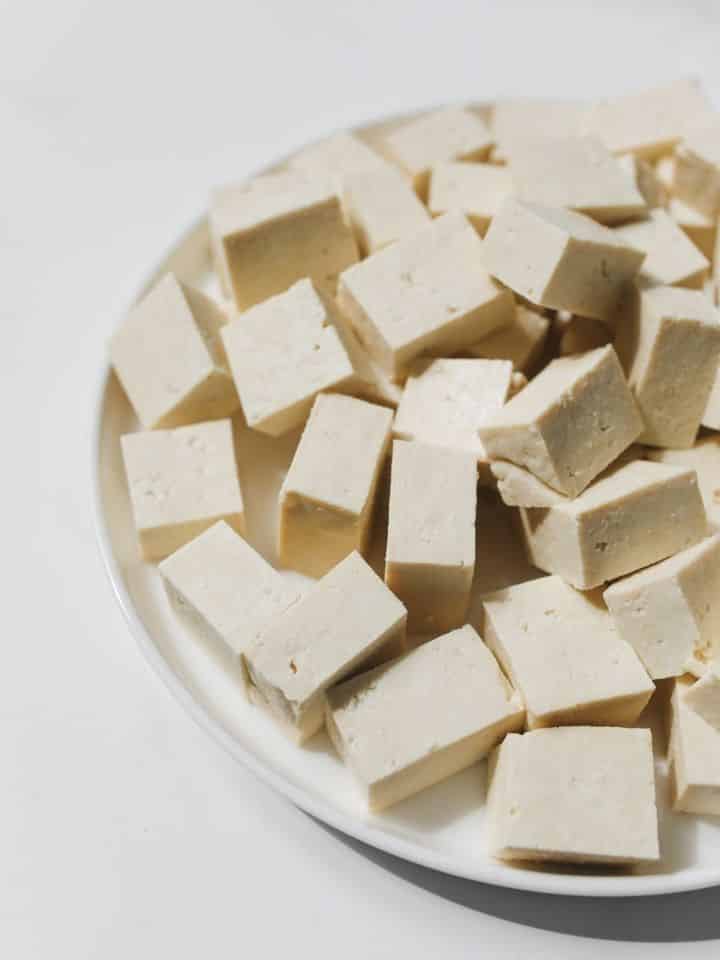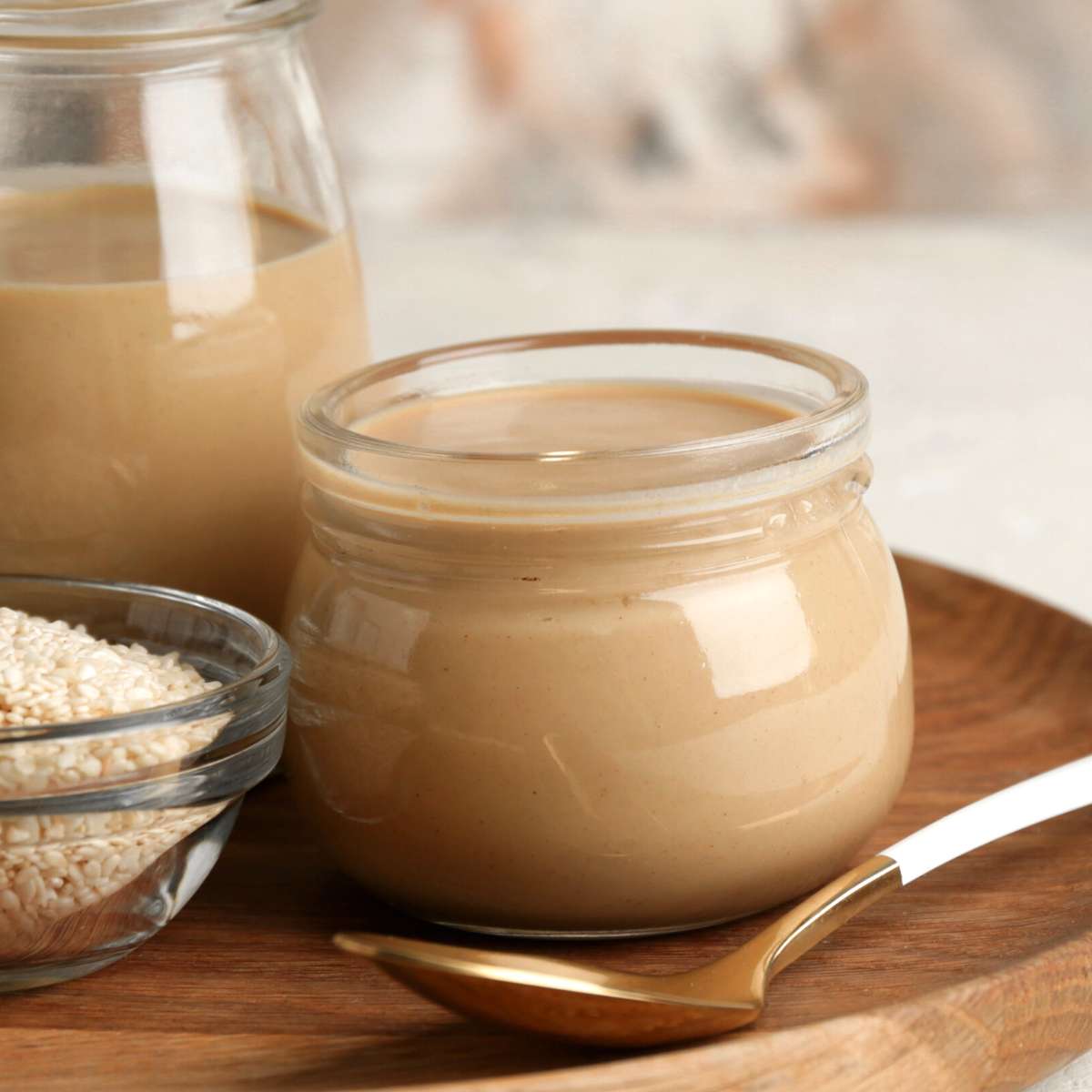Tofu: either you love it, or you’ve never had it prepared well! We’re taking a deep dive into all things tofu—what it is, nutritional benefits, types of tofu, and how to use it.
This post may contain affiliate links. Read my policy page for more information.

If you’ve ever had vegetarian or even Asian food, you’ve probably heard of tofu before. It’s a popular plant-based protein that’s common in many Asian cuisines.
It looks like a white block similar to cheese. The texture is often compared to paneer—a creamy cubed cheese found in Indian dishes—but it is definitely not cheese.
So what is it? And how do you prepare it?
I’m going to answer every question you’ve ever had about tofu so that you can cook it with confidence! Ready to become a tofu expert? Let’s dive in!
What is tofu?
It’s essentially soy milk that has been coagulated to form a solid. So it’s made similar to how cheese is made from milk. It’s also known as bean curds and is made by pressing the curds into a solid block. The varying degrees of softness is how the different types of tofu are made. We’ll get into the different types in a minute.

Is tofu fermented?
It can be, but not the kind you’re thinking of. Most tofu sold in supermarkets is going to be unfermented tofu. When it’s fermented it’s usually referred to as fermented bean curd, white bean-curd cheese, tofu cheese, soy cheese or preserved tofu. It’s more commonly used as a condiment when it’s fermented.
You might be thinking of tempeh which is fermented soy beans in their whole form. It’s also an excellent protein source but with a stronger flavor than tofu. It has higher protein and fiber content compared to tofu since it retains the entire soy bean.
What does tofu taste like?
It has a mild flavor, neutral flavor. This makes it great for adding to any dish. Its spongy texture absorbs other flavors well so it can be incorporated into almost any dish! Tofu can be savory or sweet depending on how it’s prepared. It can also be crispy or soft. It’s really versatile which makes it a great ingredient to have in the kitchen.
Who invented tofu?
Tofu originated in China but the exact date is uncertain. Many historians believe it was over 2,000 years ago when it was first discovered. There are many theories to who invented it but my personal favorite is that a Chinese cook accidentally curdled soy milk.
Nutrition in tofu
When it comes to nutrition we can often get caught up in the labels—is tofu a starch, protein or fat?
Well, technically it has all three. It provides protein, fat, and carbs. Here’s a breakdown of how much is in one serving of firm tofu (3 oz, about 1/5th of a package):
- Calories: 80
- Protein: 8 grams
- Carbs: 2 grams
- Fiber: 1 gram
- Fat: 4 grams
- Manganese: .9mg, 39% of the RDI
- Calcium: 550mg, 42% of RDI
- Selenium: 14µg, 25% of the RDI
- Phosphorus: 154mg, 12% of the RDI
- Copper: 0.3mg, 33% of the RDI
- Magnesium: 47mg, 11% of the RDI
- Iron: 2mg, 11% of the RDI
- Zinc: 1.3mg, 12% of the RDI
Source: USDA Food Database
Reference Daily Intakes (RDIs) based on FDA guidelines
Tofu will have more calcium if it’s prepared in a calcium sulfate (if not it’s more like 120mg per serving).
As you can see, tofu is pretty nutrient dense. It contains a lot of vitamins and minerals and is low in calories.
This makes tofu a great choice, nutritionally!
Doesn’t soy have estrogens?
I know this is a hot topic and comes up often when I share soy recipes so let’s address this. Soy beans contain phytoestrogens called isoflavones. Without getting too technical, these do not behave the same way that mammalian estrogens do in the body. Phytoestrogens appear to be protective against breast cancer. In fact, recurrence of breast cancer and death decreased with the increased consumption of soy foods such as tofu.
I’m not one to label foods but that sounds like a superfood to me! Soy is a hero!
If you want to learn more about the health benefits of tofu check out this article.
Varieties and preparation
Now that we know what tofu is and that it’s good for us, how do we prepare it? Well, for most recipes you’re going to want to press it.
Essentially you want to get out the excess liquid as most tofu comes packaged with water. This helps to preserve it and keep it from drying out but since tofu is spongy, we want to remove as much of the water as possible so that it can better absorb the flavors we are going to add to it.
If you’re short on time, gently press the tofu with your hands over a sink to “squeeze” out some liquid for a minute or two. If you have more time, you can use a tofu press or wrap it in a clean lint-free towel or paper towel and place a flat plate or cutting board on top with some heavy objects like cans to weight it down. Let it press for at least 15 minutes.
There are two main types of tofu and each one is better for different dishes and will be prepared in different ways.
Silken tofu

This is an unpressed Japanese-style tofu that has a custard-like texture. It comes in soft, firm, or extra firm varieties. It’s almost like an opaque jello.
With it’s softer texture, it’s better in blended dishes. I wouldn’t try roasting or sautéing or you may end up disappointed. It will most likely fall apart and not hold its shape as well. And don’t worry about pressing it. Just drain and use.
Instead, use it in desserts like puddings or creamy pies, add it to smoothies for extra protein, or blend it into sauces and dips. It is also a great egg substitute in baking.
Sometimes you’ll find it in shelf-stable boxes but it can also be found in the refrigerated section.
Tip: If you like the outdoors, bring some boxed tofu on your next camping trip since it doesn’t have to be refrigerated!
Regular tofu
This type is pressed and has a spongy texture. Depending on how pressed it is, you can find soft, firm, extra firm, and super firm varieties. The firmer the tofu, the less water content and the higher the protein content.
Soft tofu is similar to silken tofu and can be used in the same way. It is not as smooth as silken. You’ll also find it in soups like miso.

Firm is more pressed so it absorbs flavors well. This is great for stir fries, tofu scrambles, or making a substitute ricotta or feta cheese.

Extra firm has the most meaty texture and holds its shape well which makes it ideal for cubing and frying or roasting. You won’t have to worry about it falling apart but the trade off is that the firmer texture makes it harder to absorb flavors. Make sure to press out excess liquid so that it can take on the flavors you want it to better.

Super firm usually comes vacuum packed in plastic and doesn’t have to be pressed at all. This might be a good option if you’re completely new to tofu and want to skip the pressing process. It may dry out more quickly though so you’ll need to watch it if cooking at a high heat.
Can you eat raw tofu?
Yes! In fact, tofu is technically already cooked during the process of making it. Any form of tofu is safe to eat raw as long as it’s been stored properly. Additionally, you’ll want to drain off excess liquid before eating.
How to store
Most tofu will come in a plastic package packed with water. These need to be kept refrigerated until ready to use. If you open the package and don’t use all of it, leftovers can be kept in the refrigerator for up to one week by covering with water, as long as you change the water often.
Tofu can also be frozen in its original package for up to five months and it provides additional texture benefits making it spongier and able to absorb more flavor.
Where to buy tofu
You can buy tofu in the cold section of most supermarkets. This is where you’ll usually find firm or extra firm tofu. Silken tofu is most often boxed and shelf stable. Check your local Asian market as well as they will most likely have a wider selection.
If you are having trouble finding it in stores you can always purchase online.
Tofu recipes
Ready to get started?! Let’s make some tofu dishes!
Dairy-Free Ricotta (swap the cashews for firm tofu)
If you found this post helpful please leave a comment below and share it with friends or family so they can reap the benefits of tofu too!
Pin this for later:








Great blog, though Actually Paneer is in Persian dishes NOT Indian.
Thanks, Homa, I didn’t know it was Persian! Many Indian restaurants here serve it so I just assumed. Glad you are enjoying my blog 🙂